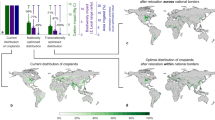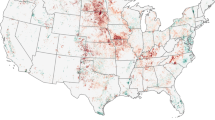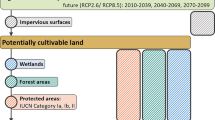Abstract
The global expansion of cropland exerts substantial pressure on natural ecosystems and is expected to continue with population growth and affluent demand. Yet earlier studies indicated that crop production could be more than doubled if attainable crop yields were achieved on present cropland. Here we show on the basis of crop modelling that closing current yield gaps by spatially optimizing fertilizer inputs and allocating 16 major crops across global cropland would allow reduction of the cropland area required to maintain present production volumes by nearly 50% of its current extent. Enforcing a scenario abandoning cropland in biodiversity hotspots and uniformly releasing 20% of cropland area for other landscape elements would still enable reducing the cropland requirement by almost 40%. As a co-benefit, greenhouse gas emissions from fertilizer and paddy rice, as well as irrigation water requirements, are likely to decrease with a reduced area of cultivated land, while global fertilizer input requirements remain unchanged. Spared cropland would provide space for substantial carbon sequestration in restored natural vegetation. Only targeted sparing of biodiversity hotspots supports species with small-range habitats, while biodiversity would hardly profit from a maximum land-sparing approach.
This is a preview of subscription content, access via your institution
Access options
Access Nature and 54 other Nature Portfolio journals
Get Nature+, our best-value online-access subscription
$29.99 / 30 days
cancel any time
Subscribe to this journal
Receive 12 digital issues and online access to articles
$119.00 per year
only $9.92 per issue
Buy this article
- Purchase on Springer Link
- Instant access to full article PDF
Prices may be subject to local taxes which are calculated during checkout




Similar content being viewed by others
Data availability
Datasets required for reproducing key results of the cropland allocation model are available via http://dare.iiasa.ac.at/74/.
Code availability
The code required for reproducing key results of the cropland allocation model is available from http://dare.iiasa.ac.at/74/.
References
van der Velde, M. et al. African crop yield reductions due to increasingly unbalanced nitrogen and phosphorus consumption. Glob. Change Biol. 20, 1278–1288 (2014).
MacDonald, G. K., Bennett, E. M., Potter, P. A. & Ramankutty, N. Agronomic phosphorus imbalances across the world’s croplands. Proc. Natl Acad. Sci. USA 108, 3086–3091 (2011).
Siebert, S. & Döll, P. Quantifying blue and green virtual water contents in global crop production as well as potential production losses without irrigation. J. Hydrol. 384, 198–217 (2010).
Carlson, K. M. et al. Greenhouse gas emissions intensity of global croplands. Nat. Clim. Change 7, 63–68 (2017).
Steffen, W. et al. Planetary boundaries: guiding human development on a changing planet. Science 347, 1259855 (2015).
Balmford, A. & Green, R. How to spare half a planet. Nature 552, 175 (2017).
Ewers, R. M., Scharlemann, J. P. W., Balmford, A. & Green, R. E. Do increases in agricultural yield spare land for nature? Glob. Change Biol. 15, 1716–1726 (2009).
Phalan, B. et al. How can higher-yield farming help to spare nature? Science 351, 450–451 (2016).
Salles, J.-M., Teillard, F., Tichit, M. & Zanella, M. Land sparing versus land sharing: an economist’s perspective. Reg. Environ. Change 17, 1455–1465 (2017).
Wilson, E. O. Half-Earth: Our Planet’s Fight for Life (Norton, 2016).
Bodirsky, B. L. et al. Global food demand scenarios for the 21st century. PLoS ONE 10, e0139201 (2015).
Popp, A. et al. Land-use futures in the shared socio-economic pathways. Glob. Environ. Change 42, 331–345 (2017).
Nelson, G. C. et al. Climate change effects on agriculture: economic responses to biophysical shocks. Proc. Natl Acad. Sci. USA 111, 3274–3279 (2014).
Mehrabi, Z., Ellis, E. C. & Ramankutty, N. The challenge of feeding the world while conserving half the planet. Nat. Sustain. 1, 409–412 (2018).
Erb, K.-H. et al. Exploring the biophysical option space for feeding the world without deforestation. Nat. Commun. 7, 11382 (2016).
Springmann, M. et al. Options for keeping the food system within environmental limits. Nature 562, 519–525 (2018).
Balkovič, J. et al. Global wheat production potentials and management flexibility under the representative concentration pathways. Glob. Planet. Change 122, 107–121 (2014).
Mauser, W. et al. Global biomass production potentials exceed expected future demand without the need for cropland expansion. Nat. Commun. 6, 8946 (2015).
Mueller, N. D. et al. Closing yield gaps through nutrient and water management. Nature 490, 254–257 (2012).
Koh, L. P., Koellner, T. & Ghazoul, J. Transformative optimisation of agricultural land use to meet future food demands. PeerJ 1, e188 (2013).
Davis, K. F., Rulli, M. C., Seveso, A. & D’Odorico, P. Increased food production and reduced water use through optimized crop distribution. Nat. Geosci. 10, 919–924 (2017).
Balmford, A., Green, R. & Phalan, B. Land for food & land for nature? Daedalus 144, 57–75 (2015).
Balmford, A. et al. The environmental costs and benefits of high-yield farming. Nat. Sustain. 1, 477–485 (2018).
Ray, D. K., Ramankutty, N., Mueller, N. D., West, P. C. & Foley, J. A. Recent patterns of crop yield growth and stagnation. Nat. Commun. 3, 1293 (2012).
Williams, J. R. The erosion–productivity impact calculator (EPIC) model: a case history. Phil. Trans. R. Soc. Lond. B 329, 421–428 (1990).
Izaurralde, R. C., Williams, J. R., McGill, W. B., Rosenberg, N. J. & Jakas, M. C. Q. Simulating soil C dynamics with EPIC: model description and testing against long-term data. Ecol. Modell. 192, 362–384 (2006).
Feniuk, C., Balmford, A. & Green, R. E. Land sparing to make space for species dependent on natural habitats and high nature value farmland. Proc. R. Soc. B 286, 20191483 (2019).
Schulte, L. A. et al. Prairie strips improve biodiversity and the delivery of multiple ecosystem services from corn–soybean croplands. Proc. Natl Acad. Sci. USA 114, 11247–11252 (2017).
Schleicher, J. et al. Protecting half of the planet could directly affect over one billion people. Nat. Sustain. 2, 1094–1096 (2019).
Ellis, E. C. Sharing the land between nature and people. Science 364, 1226–1228 (2019).
Verburg, P. H., Mertz, O., Erb, K.-H., Haberl, H. & Wu, W. Land system change and food security: towards multi-scale land system solutions. Curr. Opin. Environ. Sustain. 5, 494–502 (2013).
Puma, M. J., Bose, S., Chon, S. Y. & Cook, B. I. Assessing the evolving fragility of the global food system. Environ. Res. Lett. 10, 024007 (2015).
Alston, J. M., Babcock, B. A. & Pardey, P. G. The Shifting Patterns of Agricultural Production and Productivity Worldwide (Midwest Agribusiness Trade Research and Information Center, 2010).
Müller, D. et al. Regime shifts limit the predictability of land-system change. Glob. Environ. Change 28, 75–83 (2014).
Kastner, T., Erb, K.-H. & Haberl, H. Rapid growth in agricultural trade: effects on global area efficiency and the role of management. Environ. Res. Lett. 9, 034015 (2014).
Barzman, M. et al. Eight principles of integrated pest management. Agron. Sustain. Dev. 35, 1199–1215 (2015).
Roy, E. D. et al. The phosphorus cost of agricultural intensification in the tropics. Nat. Plants 2, 16043 (2016).
Jägermeyr, J. et al. Water savings potentials of irrigation systems: global simulation of processes and linkages. Hydrol. Earth Syst. Sci. 19, 3073–3091 (2015).
Sterling, S. M., Ducharne, A. & Polcher, J. The impact of global land-cover change on the terrestrial water cycle. Nat. Clim. Change 3, 385–390 (2013).
Folberth, C., Yang, H., Gaiser, T., Abbaspour, K. C. & Schulin, R. Modeling maize yield responses to improvement in nutrient, water and cultivar inputs in sub-Saharan Africa. Agric. Syst. 119, 22–34 (2013).
West, P. C. et al. Trading carbon for food: global comparison of carbon stocks vs. crop yields on agricultural land. Proc. Natl Acad. Sci. USA 107, 19645–19648 (2010).
Leclere, D. et al. Towards Pathways Bending the Curve of Terrestrial Biodiversity Trends within the 21st Century (IIASA, 2018).
Visconti, P. et al. Projecting global biodiversity indicators under future development Scenarios. Conserv. Lett. 9, 5–13 (2016).
Phalan, B. T. What have we learned from the land sparing–sharing model? Sustainability 10, 1760 (2018).
Tscharntke, T., Klein, A. M., Kruess, A., Steffan‐Dewenter, I. & Thies, C. Landscape perspectives on agricultural intensification and biodiversity—ecosystem service management. Ecol. Lett. 8, 857–874 (2005).
Stehfest, E. et al. Key determinants of global land-use projections. Nat. Commun. 10, 2166 (2019).
Schmitz, C. et al. Land-use change trajectories up to 2050: insights from a global agro-economic model comparison. Agric. Econ. 45, 69–84 (2014).
Schmidt-Traub, G., Obersteiner, M. & Mosnier, A. Fix the broken food system in three steps. Nature 569, 181–183 (2019).
FAOSTAT Statistical Database (FAO, 2016).
Müller, C., Bondeau, A., Lotze-Campen, H., Cramer, W. & Lucht, W. Comparative impact of climatic and nonclimatic factors on global terrestrial carbon and water cycles. Glob. Biogeochem. Cycles 20, GB4015 (2006).
Müller, C. et al. Global gridded crop model evaluation: benchmarking, skills, deficiencies and implications. Geosci. Model Dev. 10, 1403–1422 (2017).
Balkovič, J. et al. Impacts and uncertainties of +2 °C of climate change and soil degradation on European crop calorie supply. Earth’s Future 6, 373–395 (2018).
Balkovič, J. et al. Pan-European crop modelling with EPIC: implementation, up-scaling and regional crop yield validation. Agric. Syst. 120, 61–75 (2013).
Folberth, C. et al. Uncertainty in soil data can outweigh climate impact signals in global crop yield simulations. Nat. Commun. 7, 11872 (2016).
Harmonized World Soil Database Version 1.2 (FAO, 2012).
GTOPO30 - Global Topographic 30 Arc-Second Digital Elevation Model (USGS, 2002).
Skalský, R. et al. GEO-BENE Global Database for Bio-Physical Modeling (GEOBENE project, 2008); https://go.nature.com/3b3FMyh
Ruane, A. C., Goldberg, R. & Chryssanthacopoulos, J. Climate forcing datasets for agricultural modeling: merged products for gap-filling and historical climate series estimation. Agric. For. Meteorol. 200, 233–248 (2015).
Sacks, W. J., Deryng, D., Foley, J. A. & Ramankutty, N. Crop planting dates: an analysis of global patterns. Glob. Ecol. Biogeogr. 19, 607–620 (2010).
Global Spatially-Disaggregated Crop Production Statistics Data for 2005 Version 3.2 (IFPRI and IIASA, 2016).
Monfreda, C., Ramankutty, N. & Foley, J. A. Farming the planet: 2. Geographic distribution of crop areas, yields, physiological types, and net primary production in the year 2000. Glob. Biogeochem. Cycles 22, GB1022 (2008).
Portmann, F. T., Siebert, S. & Döll, P. MIRCA2000—Global monthly irrigated and rainfed crop areas around the year 2000: a new high-resolution data set for agricultural and hydrological modeling. Glob. Biogeochem. Cycles 24, GB1011 (2010).
Porwollik, V. et al. Spatial and temporal uncertainty of crop yield aggregations. Eur. J. Agron. 88, 10–21 (2017).
de Albuquerque, F. S. & Gregory, A. The geography of hotspots of rarity-weighted richness of birds and their coverage by natura 2000. PLoS ONE 12, e0174179 (2017).
Olson, D. M. et al. Terrestrial ecoregions of the world: a new map of life on Earth. BioScience 51, 933–938 (2001).
Batjes, N. H. Global Distribution of Soil Phosphorus Retention Potential (ISRIC, 2011).
Cafaro La Menza, N., Monzon, J. P., Specht, J. E. & Grassini, P. Is soybean yield limited by nitrogen supply? Field Crops Res. 213, 204–212 (2017).
Crop Nutrient Tool | USDA PLANTS (USDA, accessed March 2016).
Köble. R. The Global Nitrous Oxide Calculator—GNOC—Online Tool Manual Version 1.2.4. (JRC, 2014).
Liu, J. et al. A high-resolution assessment on global nitrogen flows in cropland. Proc. Natl Acad. Sci. USA 107, 8035–8040 (2010).
Bouwman, L. et al. Exploring global changes in nitrogen and phosphorus cycles in agriculture induced by livestock production over the 1900–2050 period. Proc. Natl Acad. Sci. USA 110, 20882–20887 (2013).
Jägermeyr, J. et al. Integrated crop water management might sustainably halve the global food gap. Environ. Res. Lett. 11, 025002 (2016).
Qin, Y. et al. Flexibility and intensity of global water use. Nat. Sustain. 2, 515–523 (2019).
Tubiello, F. N. et al. The FAOSTAT database of greenhouse gas emissions from agriculture. Environ. Res. Lett. 8, 015009 (2013).
The IUCN Red List of Threatened Species (IUCN, accessed April 2018).
Bontemps, S. et al. Consistent global land cover maps for climate modelling communities: current achievements of the ESA’s land cover CCI. In Proc. ESA Living Planet Symposium (ed. Ouwehand, L.) 9–13 (ESA SP-722, 2013); https://go.nature.com/3b3G9sF
R Development Core Team R: A Language and Environment for Statistical Computing (R Foundation for Statistical Computing, 2008).
Wickham, H. ggplot2: Elegant Graphics for Data Analysis (Springer, 2016).
Perpinan, O. & Hijmans, R. rasterVis R package Version 0.41 (2016); http://oscarperpinan.github.io/rastervis/
Acknowledgements
C.F., N.K., J.B., R.S., P.C., I.A.J., J.P. and M.O. were supported by European Research Council Synergy grant ERC-2013-SynG-610028 Imbalance-P. Part of the work by C.F. was supported by a research fellowship of the Center for Advanced Studies at Ludwig Maximilian University Munich. P.C. received support from the ANR CLAND Institute of Convergence (16-CONV-0003). We gratefully acknowledge the provision of threatened species data by IUCN and the provision of land-cover data by the ESA-CCI Land Cover project.
Author information
Authors and Affiliations
Contributions
C.F., N.K. and M.O. designed the study; C.F. and N.K. performed central analyses; J.B., R.S. and P.V. contributed models and data; C.F. wrote an initial draft; C.F., N.K., J.B., R.S., P.V., P.C., I.A.J., J.P. and M.O. contributed substantially to the interpretation of the results and revisions of the manuscript.
Corresponding author
Ethics declarations
Competing interests
The authors declare no competing interests.
Additional information
Publisher’s note Springer Nature remains neutral with regard to jurisdictional claims in published maps and institutional affiliations.
Supplementary information
Supplementary Information
Supplementary Figs. 1–20, Tables 1–4, Methods 1–4, Text 1–4 and Data 1.
Rights and permissions
About this article
Cite this article
Folberth, C., Khabarov, N., Balkovič, J. et al. The global cropland-sparing potential of high-yield farming. Nat Sustain 3, 281–289 (2020). https://doi.org/10.1038/s41893-020-0505-x
Received:
Accepted:
Published:
Issue Date:
DOI: https://doi.org/10.1038/s41893-020-0505-x
This article is cited by
-
Global spatial assessment of potential for new peri-urban forests to combat climate change
Nature Cities (2024)
-
Agricultural management practices in China enhance nitrogen sustainability and benefit human health
Nature Food (2024)
-
Crop switching can enhance environmental sustainability and farmer incomes in China
Nature (2023)
-
Could global norms enable definition of sustainable farming systems in a transformative international trade system?
Discover Sustainability (2023)
-
A decision support system based on an artificial multiple intelligence system for vegetable crop land allocation problem
Annals of Operations Research (2023)



